 School & Home Integrated Pest Management (IPM) Newsletter – May 2016
School & Home Integrated Pest Management (IPM) Newsletter – May 2016 View this newsletter as a PDF.
Editor: Shujuan (Lucy) Li, lisj@cals.arizona.edu
Authored by Shaku Nair, Dawn H. Gouge, Shujuan Li, Peter Warren, Al Fournier, Michael Wierda, Kai Umeda, Dave Kopec


The term ‘bee’ can refer to many insects belonging to different families under the insect order Hymenoptera. Bees are closely related to ants and wasps. Most bees are pollinators (Fig.1) and are regarded as beneficial, but some are feared and considered pests because of their painful stings, and damage caused by nesting activities. True honey bees belong to the genus Apis. The most common species in North America is the western honey bee (also known as the European honey bee), Apis mellifera. This species is domesticated and maintained by beekeepers for the pollination of crops and production of honey.
Wild honey bees (sometimes called feral honey bees) are those that are not domesticated by humans or maintained in managed colonies. They sometimes establish colonies among tree branches (Fig. 2). but more often utilize old or abandoned hives, natural voids such as tree hollows and stumps, rock crevices, or human-made structures such as hollow-clock walls, buildings, irrigation boxes, underground or even hives established by beekeepers. Wild honey bees are an introduced species, and are known to outcompete native bee species.
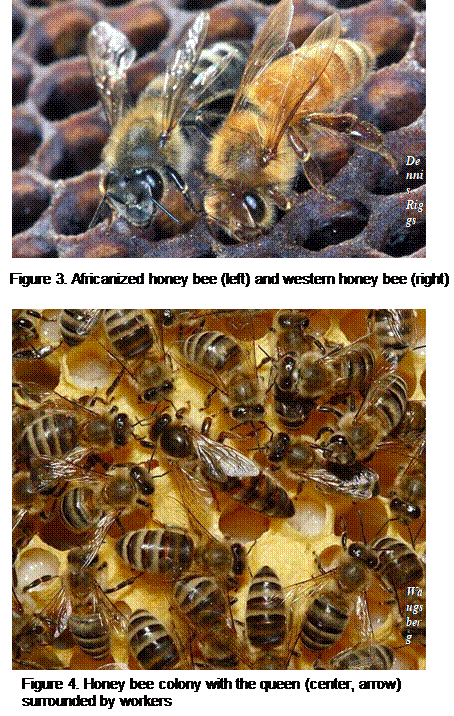 'Africanized' honey bees, also inaccurately referred to as 'Killer Bees' are descendant of hybrids between the African subspecies Apis mellifera scutellata and various European species. All wild honey bees in Arizona are ‘Africanized’ to some extent. It is difficult to distinguish between the different subspecies because their appearance and many aspects of their behavior are similar (Fig. 3). However, Africanized bees may have a larger alarm zone around their hive, which they will aggressively defend in larger numbers, more rapidly, often chasing intruders or perceived threats over longer distances. Africanized bees are generally less predictable. They exhibit more frequent swarming and migration in response to stress. Sometimes, the entire colony may migrate to a new location in a behavior called ‘absconding’.
'Africanized' honey bees, also inaccurately referred to as 'Killer Bees' are descendant of hybrids between the African subspecies Apis mellifera scutellata and various European species. All wild honey bees in Arizona are ‘Africanized’ to some extent. It is difficult to distinguish between the different subspecies because their appearance and many aspects of their behavior are similar (Fig. 3). However, Africanized bees may have a larger alarm zone around their hive, which they will aggressively defend in larger numbers, more rapidly, often chasing intruders or perceived threats over longer distances. Africanized bees are generally less predictable. They exhibit more frequent swarming and migration in response to stress. Sometimes, the entire colony may migrate to a new location in a behavior called ‘absconding’.
Identification: Adult honey bees are medium to large sized insects, about ¼ to slightly over 1 inch in length depending on the kind of adult or caste. A honey bee colony contains three kinds of adults – queen and workers (females) and drones (males) (Fig. 4). The workers are the smallest in size, the most numerous and are the individuals most often seen outside the hive. In general, the adults have robust ambercolored to dark brown bodies covered with dense hair. Light and dark stripes may be seen on the abdomen, which also has a stinger at the rear end. Mouthparts (called “proboscis”) may be seen extending below the head. Hind wings are smaller than the front pair. Hind legs are stout and equipped to gather pollen, and in workers, often have yellow pollen-balls attached to them (Fig. 1).
The hive also contains eggs, larvae (“brood”) and pupae in various stages of development (Fig. 5). Newly mated young queens leave their home colony with a group of workers to form a new colony, in a process called “swarming” and the group is called a “swarm”.
All wild honey bees in Arizona are ‘Africanized’,
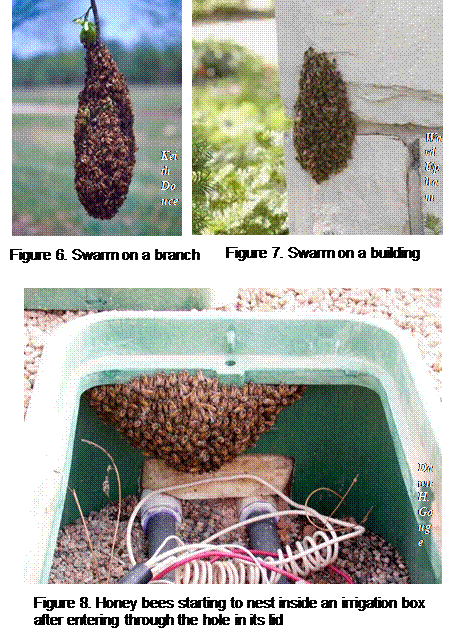 If a cluster of bees suddenly appears on a branch of a tree (Fig. 6), on a wall (Fig. 7) or on the ground (Fig. 8), this is most likely a resting swarm in search of a new home in which to set up a colony. They will often move on in a few days without intervention and are least aggressive at this time because they do not have brood to protect. However, they can sting if repeatedly disturbed or threatened. It is best to observe the swarm from a distance and hope they do not find suitable nesting sites close to your home or building. If a swarm arrives on public property and the area can be maintained offlimits using caution tape for a few days, this may be all that is needed. But if the swarm is located close to or on a pathway or doorway it may be necessary to have the swarm removed by professionals.
If a cluster of bees suddenly appears on a branch of a tree (Fig. 6), on a wall (Fig. 7) or on the ground (Fig. 8), this is most likely a resting swarm in search of a new home in which to set up a colony. They will often move on in a few days without intervention and are least aggressive at this time because they do not have brood to protect. However, they can sting if repeatedly disturbed or threatened. It is best to observe the swarm from a distance and hope they do not find suitable nesting sites close to your home or building. If a swarm arrives on public property and the area can be maintained offlimits using caution tape for a few days, this may be all that is needed. But if the swarm is located close to or on a pathway or doorway it may be necessary to have the swarm removed by professionals.
Once a swarm finds a suitable home site, they start to build comb and rear brood. Problems arise when they establish a colony in a place where they pose a risk to people (Fig. 9). In this situation, bees can become pests because of sting incidents, defensive bee attacks, and the structural damage and annoyance that their foraging and nest-building activities can cause. The chances of people getting stung in such situations are much higher once brood are being reared. Most honey bees observed in the landscape are foraging bees from established colonies looking for water, nectar or other sugary, sweetsmelling substances. But if you see multiple bees passing in and out of a cavity, this indicates the presence of a colony within.
Bees and combs should be removed by professionals who have appropriate personal protective equipment.
There are many kinds of bees and bee-look-alikes. Many of these are beneficial and harmless to people but most can sting if disturbed or provoked. Try to identify the bee or wasp before deciding if it’s a real problem or not.
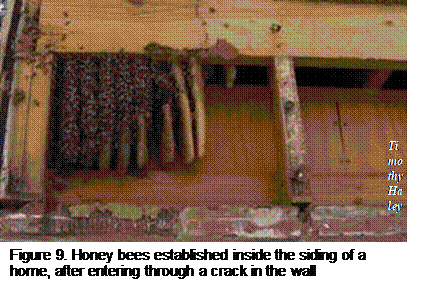
Pollinators are important and desirable elements in our natural environment. But wild honey bees can sometimes interfere with our activities or interests. When this happens the best course of action is to take an integrated pest management (IPM) approach.
Inspect and monitor your home and surroundings regularly
(http://cals.arizona.edu/apmc/docs/WildHoneyBeeIPM1.pdf) for signs of honey bee activity. Confirm that you have honey bees and that they are posing a risk. There are many kinds of bees and bee-look-alikes. Many are beneficial or benign and do not necessitate action, e.g. bumblebees, leaf-cutter bees and sweat bees, while others pose risks, e.g., yellowjackets.
Be aware of potential health risks and injury. It is important to be aware of stinging insect activity in an area before engaging in outdoor activities, particularly if individuals sensitive to stings are involved. Avoid contact with these insects as much as possible and teach children to do the same. Tragic loss of life has occurred when people intentionally irritated honey bees. Swarming or foraging wild honey bees are usually focused on the job at hand, and will not sting if left alone. However, they may react defensively to prolonged disturbance such as being poked with a stick, or water being thrown at them. Established colonies may be highly defensive and may respond in large numbers if provoked.
Respond appropriately to honey bees around you. If you encounter bees buzzing around your head, place your hands over your face and look through gaps between your fingers. Look around for signs a colony is close by, and walk briskly away from the area. Do not flap or swat at the bees, this is the worst thing you can do!
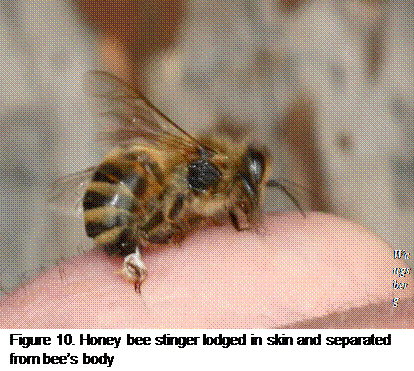 If you are stung or the bees bump you, cover your head and face with clothing or your hands and run to the nearest building, car or shelter, go inside and close the doors. If you are outdoors and not close to shelter, run at least 240 yards (the length of two football fields) or until the bees have abandoned you.
If you are stung or the bees bump you, cover your head and face with clothing or your hands and run to the nearest building, car or shelter, go inside and close the doors. If you are outdoors and not close to shelter, run at least 240 yards (the length of two football fields) or until the bees have abandoned you.
Do not dive into a swimming pool or river; the bees will wait for you longer than you can hold your breath!
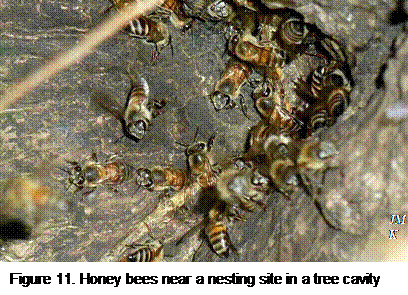 Honey bee stingers get lodged in the skin and torn out of the bee’s body along with the venom glands (Fig. 10). This results in the death of the bee, but the stinger continues to release venom for several minutes. It is important to scrape off the stinger (or at least the venom gland) as soon as possible to reduce the amount of venom that enters the body. Prompt removal using any available means can greatly reduce the severity of the sting.
Honey bee stingers get lodged in the skin and torn out of the bee’s body along with the venom glands (Fig. 10). This results in the death of the bee, but the stinger continues to release venom for several minutes. It is important to scrape off the stinger (or at least the venom gland) as soon as possible to reduce the amount of venom that enters the body. Prompt removal using any available means can greatly reduce the severity of the sting.
Bee stings are painful, and the discomfort and swelling can last 2-3 days. Prolonged or severe reactions may occur in sensitive people, and this is the most significant problem. Most healthy adults can withstand several hundred bee stings, so fatalities due to toxic levels of venom are extremely rare.
Prevent bees from nesting in and around your home. Honey bees need food, water and shelter to survive. Restricting access to suitable nesting sites will encourage them to go elsewhere to live.
Honey bees can enter open soda cans and cause stings in and around your mouth!
For identification, biology, inspections and monitoring honey bees, please view: http://cals.arizona.edu/apmc/docs/WildHoneyBeeIPM1.pdf
You can prevent honey bees from nesting in an around your home by following steps outlined in http://cals.arizona.edu/apmc/docs/WildHoneyBeeIPM2.pdf
Gouge, D.H., Olson, C., Rehm-Bowler, M. Enriquez, N., Rodriguez, J.M. Bee Management. http://cals.arizona.edu/urbanipm/buglist/bees.pdf
Arizona Bee Identification Guide http://pollinator.org/PDFs/AZ_bee_guide_FINAL.pdf
Africanized Honeybees B-Smart information and Safety Rules. http://www.maricopa.gov/emerg_mgt/pdf/killerb.pdf